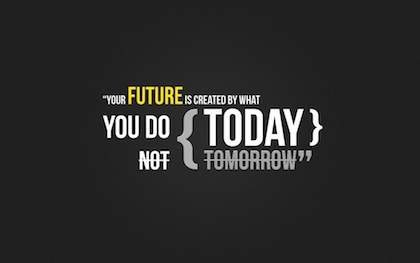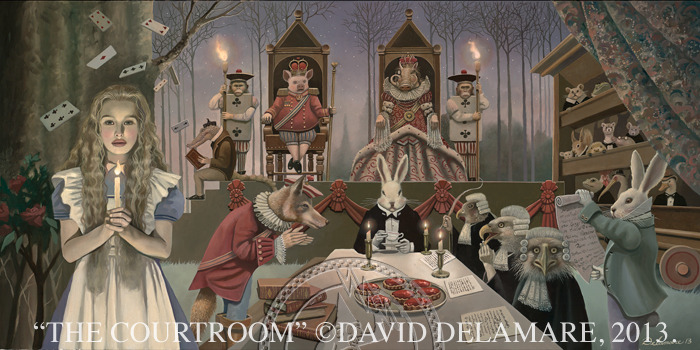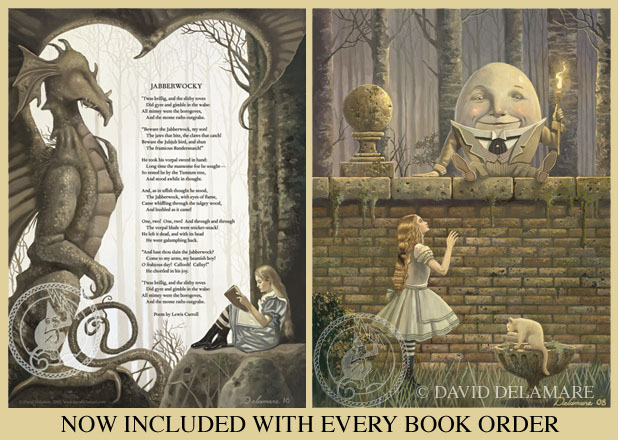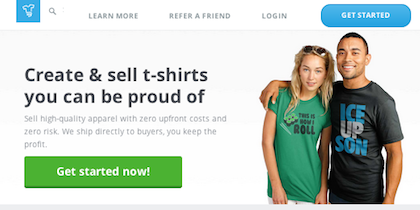The Alice in Wonderland Book campaign has raised over $54,000 in 13 days on Kickstarter. Described as a “A deluxe limited edition volume richly illustrated with paintings and drawings by artist David Delamare,” this campaign has managed to attract over 600 backers and is still raising money for a remaining 20 days.
For all aspiring creators that would like to raise money via crowdfunding, I would recommend reading through the interview I did with Wendy Ice, David Delamare’s partner and print publisher. She had some great insights into online fundraising and let us in on the ground floor of the Alice in Wonderland Book campaign. You can see the results below.
Did you expect to reach your fundraising goal so soon? Where are the pledges coming from?
Absolutely not. We thought that our $35,000 goal was overly ambitious. Kickstarter’s all or nothing system is intimidating and it’s tempting to ask for less than what you need. But as frightening as it was to imagine failure, it was even more daunting to imagine being obligated to produce something we couldn’t afford. I was terrified to push the launch button and, afterwards, sat for about 15 minutes staring at the zeroes thinking “what have I done?”. I was actually afraid to show the campaign to anyone, and announced it first to personal friends. It took awhile before I posted on Facebook.
The first day we did really well, making over $5,000, mostly from familiar clients. Then suddenly, on day two, the pledges started pouring in. I had no idea why until I checked the dashboard and saw that Kickstarter had selected us as one of three “Projects We Love” for their weekly newsletter.
When I realized the statistical unlikelihood of this, I burst into tears. I knew there was a large amount of luck involved, but at the same time it was very validating. Today as I look at my dashboard, I see that 54% of our pledges were a direct result of that newsletter. I still don’t know with certainty whether we would have hit our goal without it, but I also know that getting chosen was no guarantee of success. We got more exposure, but we still had to make the sale.
What was your process preparing for the campaign? Did you do any media embargos? Hire any consultants?
 Kickstarter had been suggested by a friend, but I hadn’t gotten around to researching it. Then on November 7th a young artist named Ulysses, (for whom my partner is a kind of “art hero” ) wrote to ask if we would support his Kickstarter campaign. I made a modest pledge and told him how tough business had been. He began writing to me, and on November 15th he sent a long email in which he summarized, “I am telling you, begging you to do Kickstarter.” Then he started sending links to articles. Here was this stranger with a job, a child, and his own Kickstarter campaign to manage, but he was determined to help us.
Kickstarter had been suggested by a friend, but I hadn’t gotten around to researching it. Then on November 7th a young artist named Ulysses, (for whom my partner is a kind of “art hero” ) wrote to ask if we would support his Kickstarter campaign. I made a modest pledge and told him how tough business had been. He began writing to me, and on November 15th he sent a long email in which he summarized, “I am telling you, begging you to do Kickstarter.” Then he started sending links to articles. Here was this stranger with a job, a child, and his own Kickstarter campaign to manage, but he was determined to help us.
That’s been my experience with crowd funding. Everyone has been so generous. As a small business owner I often feel isolated. Crowd funding has made me feel part of a community. And that’s not just the backers (who have given me great suggestions). I was astonished, for instance, that you contacted me.
So, getting back to your question… no consultants, and no media except a cover story in the local community paper about how we were using Kickstarter to jumpstart a struggling art business. Research consisted of scattered articles found online. Unfortunately, I didn’t really discover crowdcrux until mid-campaign. We printed 5,000 postcards which we distributed around town, starting on the day of the launch. We also announced an event to our Oregon customers that we saw as a kind of launch (it was on day two of the campaign.) However, we met our goal on the way to the event, so it turned out to be more of a celebration.
How have you gone about marketing and promoting the crowdfunding campaign after launch?
We sent out holiday postcards with Kickstarter information to our 400 most recent paying customers and we sent an email newsletter to nearly 5,000 fans letting everyone know that the campaign was live. We’ve been pushing it on Facebook, and been trying to get a handle on Twitter and Pinterest (which we’ve never fully utilized). Full confession: until yesterday I didn’t know how to use a hash tag. I had avoided Twitter because I couldn’t think of anything to say. I realize now that we could have been posting artwork instead of words, which would have had more impact anyway.
What do you think is the key part about crowdfunding that most people don’t understand?
If you’re serious about it and work hard, it’s well worth doing even if you fail to make a dime. It’s free market research, free advertising, it puts you in touch with dozens of helpful individuals, and it’s highly motivating. The sheer terror of missing that goal kicked me into a kind of focus I’ve never had (the Kickstarter name is appropriate in more ways than one).
I’ve learned more about marketing in the past month than in the last ten years combined. I will be a far better businessperson as a result of this experience and that has nothing to do with reaching our goal. That said, I think for a hard-working person with a sound project, a solid presentation, and a reasonable goal, the odds for success are high. Look at the stats and then check the “recently launched” page. You’ll see just how many creators launch projects and walk away. Seriously? 0% funded after a week? A lot of folks aren’t even trying, and, of course there are a lot of silly or badly presented projects. Take all these projects out of the equation and your odds are very, very good.
Have you learned anything about the process of raising money online that you didn’t previously know?
It’s a huge amount of work and you can’t shrink from that. Don’t launch unless you’re ready to throw yourself into the campaign. If you can’t drop everything, then make sure you’ve done a tremendous amount of prep work. Compose your emails in advance. Have your stretch goals worked out ahead of time (you might need them sooner than you think). Make sure you’ve got replacement rewards for limited items that might sell out quickly. Have your press releases ready before launch. Make sure you’ve got a solid social media base and use it to build anticipation. (These are all areas in which we failed.) Above all, be sincere and transparent. You’re not building a customer base, you’re building a community.
What strategies are you taking now that you have reached your fundraising goal to continue to reach new backers? Have you done any paid ads (if so, have they been effective?).
Activity slowed dramatically when that green bar reached 100%. I think a lot of backers glancing at the campaign think that it’s over. So you really do have to work much harder to get pledges after you hit your goal. We haven’t yet purchased ads, though that’s a good idea. We’ll be buying a list of bloggers from crowdfundingpr.org and sending press releases. We also set up an account at postrunner.com so that I can submit guest blogs. Finally, though we should have done it sooner, we’ll try to get some mainstream press. Meanwhile I’m researching every single day to see if there’s anything I’ve missed that can still be implemented. This has led me to all sorts of great tools such as bitly.com, twitpic.com, and bufferapp.com. I still don’t have a tumblr account, and I haven’t yet utilized Reddit or Skype. Great free tools, and all completely worthless if you don’t use them.
Exciting news!
We recently passed the 150% mark with 600 backers and are now adding stretch bonuses for every additional $5000 that we raise. The collective retail value of those gifts will soon be equivalent to the book and if we keep doing well, the stretch bonuses will ultimately be worth even more. Basically, each backer is going to end up with a very cool package of goodies. We can do this because the items are light and will fit in the same package with the book. It’s really wonderful, after feeling so grateful to these strangers to be able to return the favor. We can’t wait to start sending everything out!








